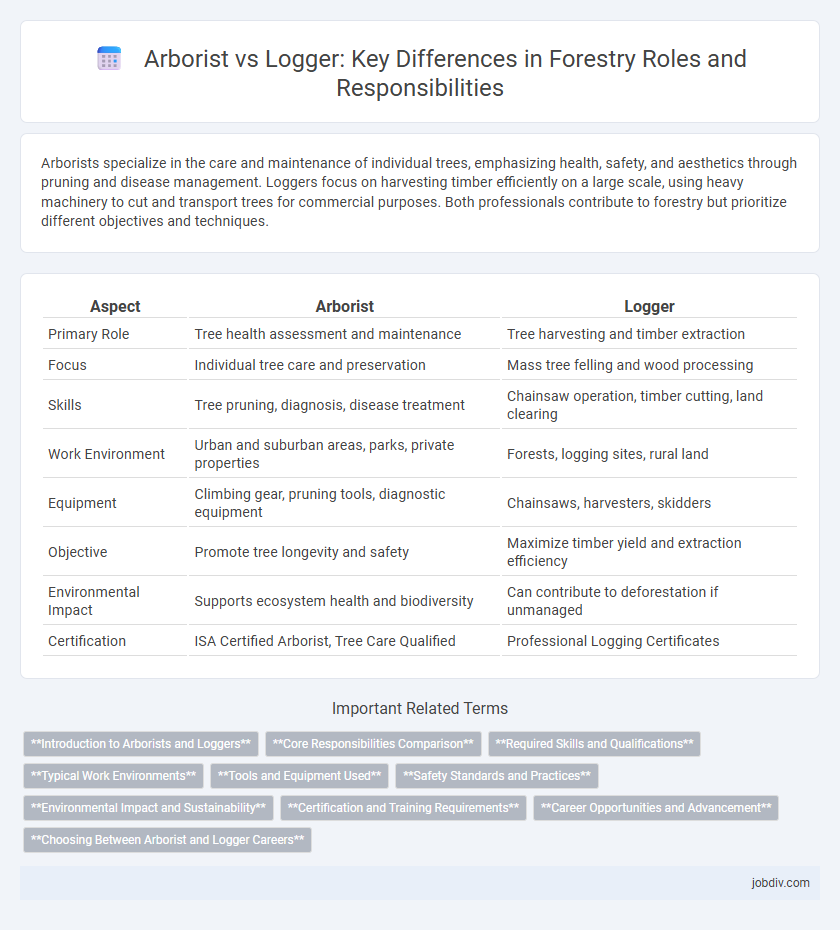Arborists specialize in the care and maintenance of individual trees, emphasizing health, safety, and aesthetics through pruning and disease management. Loggers focus on harvesting timber efficiently on a large scale, using heavy machinery to cut and transport trees for commercial purposes. Both professionals contribute to forestry but prioritize different objectives and techniques.
Table of Comparison
| Aspect | Arborist | Logger |
|---|---|---|
| Primary Role | Tree health assessment and maintenance | Tree harvesting and timber extraction |
| Focus | Individual tree care and preservation | Mass tree felling and wood processing |
| Skills | Tree pruning, diagnosis, disease treatment | Chainsaw operation, timber cutting, land clearing |
| Work Environment | Urban and suburban areas, parks, private properties | Forests, logging sites, rural land |
| Equipment | Climbing gear, pruning tools, diagnostic equipment | Chainsaws, harvesters, skidders |
| Objective | Promote tree longevity and safety | Maximize timber yield and extraction efficiency |
| Environmental Impact | Supports ecosystem health and biodiversity | Can contribute to deforestation if unmanaged |
| Certification | ISA Certified Arborist, Tree Care Qualified | Professional Logging Certificates |
Introduction to Arborists and Loggers
Arborists specialize in the care and management of individual trees, focusing on tree health, safety, and aesthetics through pruning, disease control, and risk assessment. Loggers concentrate on the harvesting of timber, using heavy machinery and techniques to cut, process, and transport large quantities of wood efficiently. Both professions play crucial roles in sustainable forest management, balancing environmental stewardship with resource extraction.
Core Responsibilities Comparison
Arborists specialize in the care and maintenance of individual trees, focusing on health assessment, pruning, disease treatment, and ensuring structural integrity, often in urban or residential settings. Loggers concentrate on the harvesting, felling, and transportation of timber from forested areas, emphasizing efficiency, safety, and sustainable forestry practices. While arborists prioritize tree preservation and long-term health, loggers manage large-scale timber production and forest resource extraction.
Required Skills and Qualifications
Arborists require specialized knowledge in tree biology, health assessment, and safe climbing techniques, often holding certifications like ISA Certified Arborist to demonstrate expertise in tree care. Loggers must possess skills in operating heavy machinery, felling trees safely, and understanding forest management regulations, typically acquiring certifications in equipment operation and safety training. Both professions emphasize physical fitness and adherence to environmental and occupational safety standards specific to forestry operations.
Typical Work Environments
Arborists typically work in urban and suburban settings, managing individual trees in parks, residential areas, and commercial properties to ensure tree health and safety. Loggers operate primarily in remote forested areas, harvesting timber using heavy machinery in rugged terrains, often under challenging weather conditions. Both professions require knowledge of tree species and safety protocols but differ substantially in their daily work environments and operational scopes.
Tools and Equipment Used
Arborists primarily use precision tools such as climbing spikes, pruning saws, pole pruners, and rigging gear to safely manage and maintain tree health. Loggers rely on heavy machinery like chainsaws, feller bunchers, skidders, and loaders designed for efficient tree harvesting and timber transport. The specialized equipment reflects the arborist's focus on individual tree care versus the logger's emphasis on mass timber extraction.
Safety Standards and Practices
Arborists follow strict safety standards such as ANSI A300 and OSHA regulations specific to tree care, emphasizing personal protective equipment (PPE), fall protection, and careful hazard assessment to minimize risks. Loggers adhere to rigorous safety protocols guided by OSHA logging regulations, including the use of high-visibility clothing, machine guarding, and safe felling techniques to prevent accidents in high-risk environments. Both professions require continuous training and adherence to industry best practices to ensure worker safety and reduce injury rates in forestry operations.
Environmental Impact and Sustainability
Arborists prioritize the health and preservation of individual trees and urban forests, promoting biodiversity and minimizing environmental damage through selective pruning and disease management. Loggers focus on timber extraction, often involving clear-cutting or large-scale harvesting techniques that can disrupt ecosystems, increase soil erosion, and reduce carbon sequestration. Sustainable forestry practices encourage collaboration between arborists and loggers to balance economic needs with ecosystem conservation and long-term forest resilience.
Certification and Training Requirements
Arborists typically require certification from organizations such as the International Society of Arboriculture (ISA), which mandates rigorous training in tree biology, safety procedures, and pruning techniques. Loggers often complete specialized training programs focused on safe timber harvesting, equipment operation, and environmental regulations, with certifications like the Professional Logging Manager (PLM) credential available in some regions. Both professions prioritize ongoing education to ensure adherence to industry standards and safety protocols in forestry management.
Career Opportunities and Advancement
Arborists have diverse career advancement opportunities in urban forestry, tree care management, and consulting, often requiring certification and specialized training. Loggers' career growth typically involves gaining experience in timber harvesting, equipment operation, and moving into supervisory or management roles within logging companies. Both careers offer pathways to higher salaries and increased responsibilities, but arborists generally access broader professional development options through horticulture and environmental sectors.
Choosing Between Arborist and Logger Careers
Choosing between arborist and logger careers depends on whether one prioritizes tree care or timber harvesting. Arborists specialize in tree health, maintenance, and preservation, often working in urban and residential settings. Loggers focus on harvesting trees for commercial use, requiring physical endurance and knowledge of forestry equipment.
Arborist vs Logger Infographic

 jobdiv.com
jobdiv.com